
How Dangerous a Meteor Isn't Determined by Size
Share
We owe a lot to meteorites. If they hadn't caused several mass extinction events, including wiping out non-avian dinosaurs, we might not be here now.
Despite that, some things don't add up about how much damage they can do.
Scientists have wondered for decades why some meteorites cause mass extinctions, while others, even really big ones, don't, says sedimentologist Chris Stevenson at the University of Liverpool.
Usually, mass extinctions are blamed on impact winters - huge volumes of exploding ground smother out sunlight, starving plants and algae and plunging the planet into a cold state.
As a result, larger meteorites, which can propel greater dust blankets into the sky, would impact the biosphere more than smaller ones.
This isn't what Earth's geological records show.

"It's surprising when we put together the data,'' explains Stevenson. "Life carried on as normal during the 4th largest impact with a crater diameter of ~48 km (30 miles), whereas an impact half the size was associated with a mass extinction only 5 million years ago."
In most cases, impact winters last only a few years, but upflung dust can last up to 100,000 years.
Matthew Pankhurst from the Technological and Renewable Energy Institute in Spain and his colleagues analyzed this ejected dust from 44 meteor impacts over 600 million years.
"Using this new method for assessing the mineral content of the meteorite ejecta blankets, we show that every time a meteorite, big or small, hits rocks rich in potassium feldspar it correlates with a mass extinction event," says Stevenson.
It's been like this for 600 million years.
Meteorite impacts on feldspar-poor rocks only cause background extinctions, the team writes in their new paper.
Feldspars are aluminium-silicate rocks that crystallize from magma. They make up around 60 percent of the Earth's crust. Potassium feldspar is common in many soils, and unlike other substances smashed into our atmosphere during meteor impact - like acid rain causing hydrocarbons - it has no toxic after effects.
Despite this, potassium feldspar is a powerful ice-nucleating aerosol that can mess with cloud composition.
Once the immediate effects of blasting Earth's ground into the air (impact winters) wear off, chemistry in the air starts to matter. If it's normal clay dust, the climate system will rebalance, but if it's potassium feldspar, it messes with Earth's cloud dynamics in two important ways.
Because there are more ice-nucleating minerals in the air, clouds will contain more ice crystals than dense water droplets normally found in lower, warmer regions of the sky, which makes them more transparent. This reduces the reflective effect water droplets clouds usually have (their albedo), so more light gets through to warm things up.
Weakening albedo also suppresses cloud cooling feedback mechanisms, increasing climate sensitivity. In turn, this makes the whole climate system more vulnerable to other disruptions, like increased volcanic emissions.
Volcanic eruptions aren't always associated with mass extinctions, but others are. These ones are also linked to more potassium feldspar in the atmosphere.
"Many kill mechanisms only variably correlate with extinction events through geological time: they coincide with these rare periods of climate destabilization by atmospheric potassium feldspar," the researchers write.
It's crazy how powerful something that doesn't directly hurt us can be when it's in the wrong spot.
"This strongly suggests that the driver of severe extinction episodes is a critical change in atmospheric function," Pankhurst and colleagues write.
"Anthropogenic activities may represent similar climate forcing with the rapid input of aerosols into the atmosphere that influence cloud dynamics."




